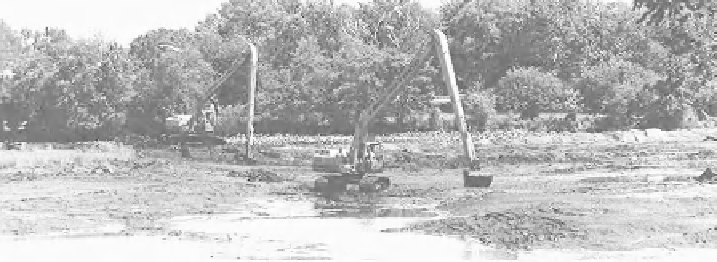Environmental Engineering Reference
In-Depth Information
limestone to the lake surface is the most com-
monly employed method for decreasing lake
acidity. Because limestone is used for agricultural
liming, it is usually available at low cost. However,
the cost of the limestone dispersal can be signifi-
cant, particularly for remote lakes without road
access. Repeated applications are usually needed,
and lakes with short water retention times may
need to be treated annually.
Injection of Base Materials into the Lake Sedi-
ment.
Limestone, hydrated lime, or sodium car-
bonate can be injected into the lake sediments,
resulting in a gradual decrease in lake acidity. This
technique is largely experimental, and is limited to
small, shallow lakes with soft organic sediments
and road access for transport of the application
equipment. The treatment may remain effective
substantially longer than surface applications, but
the lake's benthic community is disturbed, turbid-
ity may increase, and the costs are higher.
Mechanical Stream Doser.
Lake acidity may be
decreased by neutralizing the acidic waters in
upstream tributaries. Mechanical dosers are
automated devices that release dry powder or
slurried limestone directly into the stream, with
the quantity of material added controlled by mon-
itors of stream flow or stream chemistry. The treat-
ment is continuous, expensive, and generally not
recommended for lakes unless all other alterna-
tives are not feasible.
Limestone Addition to the Watershed.
Limestone is
spread on all or parts of the lake's watershed,
decreasing the acidity of runoff and shallow
groundwater flow into the lake. Although the costs
of one application are higher, the overall costs
may be lower than for limestone applications to
surface waters, because the effects are much more
long lasting. Watershed liming may be especially
appropriate for lakes with short retention times
(less than 6 months). Liming of soils also increases
their fertility and pollutant retention capacity.
Pumping of Alkaline Groundwater.
Where abundant
supplies of alkaline groundwater are available,
these waters may be discharged directly into lakes
or lake tributaries, decreasing acidity. Applications
of this method have been limited.
7.6.4 Control of Aquatic Plants
In lakes and reservoirs where thick beds of macrophytes
cover a high proportion of the lake bottom, an aquatic
plant control program may be needed to improve yields
of large, predatory game fish and increase the growth
rates of panfish species, such as bluegill and white and
black crappie. For lake uses such as swimming and
boating, minimizing macrophyte beds are desired. For
fisheries management, on the other hand, moderate
growths of aquatic plants enhance the fisheries. The
complete elimination of macrophyte beds may be as
harmful to fisheries as are excessive plant growths.
The objective of aquatic plant management is to
provide the appropriate amount of aquatic plants, taking
into account the effects of macrophytes on fish com-
munities, other lake uses (e.g., swimming and boating),
nutrient cycles, and aesthetics. Macrophytes and terres-
trial vegetation also help to stabilize the lake bed and
shoreline, reducing problems with lakeshore erosion
and high turbidity.
Excessive plant growth as a result of eutrophication
or the inadvertent introduction of an exotic macrophyte
species is a common lake problem. Approaches to con-
trolling nuisance plant growths are described below.
Sediment Removal and Sediment Tilling.
Lakes can
be dredged to remove sediments and deepen the
lake so that less of the lake bottom receives ade-
quate light for macrophyte growth. Portions of
lakes are frequently dewatered prior to dredging,
as shown in Figure 7.18. The maximum depth at
Figure 7.18.
Lake dredging.
Source
: Delta Contracting of New Jersey (2005).

Search WWH ::

Custom Search